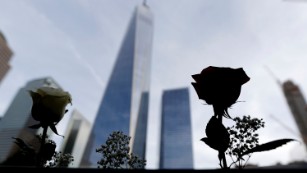CNN)I never planned on becoming a fireman. As a young New York actor, my brother had persuaded me to take the test so that I had something to fall back on if the acting thing didn’t work out. I could never have imagined how, years later, what would turn out to be my two big passions would end up intersecting. That day. The day the world changed.
It was the late 1980s when I took the test. But nothing prepares you for the Fire Department of New York. It’s a job like no other. Hell, I barely made it through Probie School — I just wasn’t used to the discipline and military-like protocols. But somehow I made it, and about six weeks later I was assigned to Engine 7 and Ladder 1 on Duane Street in Lower Manhattan.
I remember a job right at the beginning, in Chinatown. As we approached the door with the line I started to put on my mask. “You’re half a man if you put on that mask, kid.” I didn’t put it on. I was scared to death to be honest, and when it was over I was just excited to be alive — even as I was sick and dry-heaving all the way back to the firehouse.
In my first seven years, we lost 27 firefighters in fatal fires. They were terrible losses. But I always felt it was a privilege to be a FDNY fireman, working for years among those who were giants and heroes.
Indeed, it was because of all my experiences — good and bad — that I decided to make a documentary, to show what it’s like to be a New York City fireman. So, back in May 2001, I started filming a documentary about a probie FDNY firefighter, Tony Benetatos. We had three cameras, and set out to follow the nine-month probationary period and to give viewers a sense of what it takes to be a New York firefighter.
It actually took me a year and half to get permission to shoot the film. And even once I had it, after calling in every favor I could, Tony was assigned to Ladder 28 in Harlem. But that would never work — I wouldn’t have time to film him and then make it downtown for my own shifts. So I called Chief Larry Byrnes of my firehouse and asked if Tony could be reassigned to my firehouse, 12 blocks north of the twin towers.
If I hadn’t been able to move Tony’s assignment, then what turned into the 9/11 documentary never could have happened.
It was hell in the beginning. For a start, the guys were really pissed that I was pointing a lens into a private world. But the biggest problem was that Tony was what the FDNY calls a “white cloud,” a firefighter who is there ready to work but doesn’t get called out. So we would film him for a 15-hour tour, but there would be no action. And almost inevitably, as soon as he would put his gear away and I’d start my shift, we’d catch a job. After weeks with Tony, we hadn’t managed to get any footage. Like one colleague said, what we really had were the makings of a firehouse cooking show.
But then, there was 9/11.
A few nights before, we had gone up with Tony to the firehouse parapet to talk with him and try to get a good shot. It was the last time we filmed the towers before that morning.
So many memories fill my mind about that day. Being the only ones with access down at the site after the towers fell. Having guys tell their stories on the third floor of the firehouse as we sat them between two stacks of mattresses. John O’Neill’s 34-second pause before he finally says the words, “It’s not easy being a survivor,” still sends chills down my spine. He would say those same words to me just a few years later, as he lay dying of multiple 9/11-related cancers. May he rest in peace.
I could go on and on, but many of those memories I keep to myself. They are burned into my mind.
A person can try to explain what it’s like to fight a fire, save someone’s life or witness a horrible tragedy. And while those words can’t help someone to experience what it’s really like, I am still happy I was able to tell the story of the bravest men I ever had the chance to work with. It’s experience I’ve drawn on recently, even when shooting an episode of “NCIS Los Angeles,” “Where There Is Smoke …,” a fire department-based episode with Chris O’Donnell and LL Cool J that didn’t require me to do much in the way of research.
And it’s a desire to try to help people understand the work these everyday heroes do — especially those on 9/11 — that has prompted me to keep updating the 9/11 film from the beginning, every five years, with interviews of the surviving members of Engine 7 and Ladder 1, my old FDNY firehouse featured in the film.
Our five-year update centered on post-traumatic stress disorder. The 10-year update focused on the cancers and other illnesses that were affecting the firefighters involved (hat tip to former Directors Guild of America President Michael Apted for the idea of the five-year updates).
Follow CNN Opinion
Now, as the 15th anniversary approaches, we have decided to look to the future and the rebuilding of the FDNY and the new One World Trade Center, the beautiful rebuilding of the ground zero site, and theNational September 11 Memorial & Museum. Much of the update, which includes about 21 minutes of new footage, will focus on the new FDNY and the “Legacy Kids” — teenagers who lost a member of their family on 9/11 and grew up to follow in their fathers’ footsteps. These young men are a big part of the new FDNY.
I don’t think I have gone more than a few days since 9/11 without talking, emailing or texting with some of the guys from the film. I’ve tried to live my life since 9/11 in a positive and forward-looking way. But I owe it to the men and women to play my part in not letting us forget those who cannot be here today because of that terrible tragedy.
May we never forget that September 11. May God hold in his arms all those we lost that terrible day. And may he continue to bless the FDNY.




No comments yet.